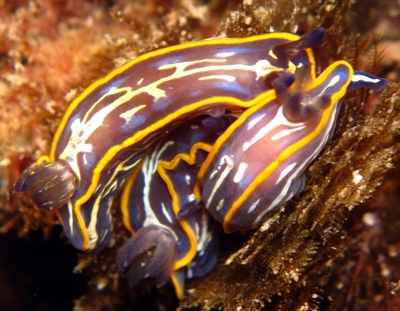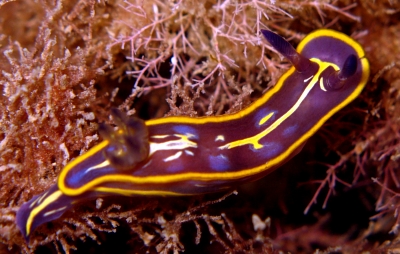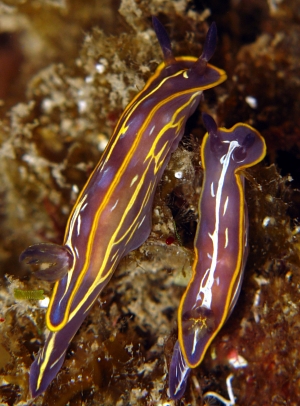Re: Hypselodoris fontandraui from Cannes
June 26, 2006
From: Dominique Horst


Concerning message #16844:
Hi Bill,
I've identified the following as again H.fontandraui. I guess you will confirm this.
Locality: Cap d'Antibes, 13m, France, Mediterranean sea, 21 June 2006, vertical rock. Length: 20mm. Photographer: Dominique Horst.
Looking at all the pictures I've have now of this dorid, I am surprised at the variability of this species especially the patterns and colors. Sizes of these all were very different so I assume that their respective sizes are related to their ages. Have you any idea on how long these dorid live ?
Also, is their variability related to their age ? That is, do their colour patterns change a lot during their life ? And also, is their variation in colour pattern between male and female ?
Thanks in advance,
Kind regards,
Dominique
dominique.horst@wanadoo.fr
Horst, D., 2006 (Jun 26) Re: Hypselodoris fontandraui from Cannes. [Message in] Sea Slug Forum. Australian Museum, Sydney. Available from http://www.seaslugforum.net/find/16953
Dear Dominique,
I will start with your last question first, because it has an easy answer. All sea slugs are hermaphrodite, that is they have full functional male and female reproductive systems, so there can be no gender differences in colour pattern.
Concerning age and colour patterns, there are certainly obvious differences in very small juveniles in which colour pigmentation is first appearing, but once that stage is past most species can be recognised by their colour pattern, even if there are some differences between young and adult animals. In many species we just don't have enough observations to say whethre there are distinct 'adult' and 'juvenile' colour forms. From what I can read about H. fontandraui, there seems to be some differences between juveniles and adults, with juveniles having a darker blue background colour and the median line between the rhinophores and the gills being white rather than yellow. However the many other differences you and others have illustrated don't seem to be age-related.
However if you regularly visit a place where there is a fairly constant population of the species, it would be fairly easy for you to study this very question. All you would need to do is regularly take photos of animals of varying sizes for a few months and see if there is any correlation between colour, colour pattern and length. The simplest way to record the length of your animals would be to take a small centimeter scale with you and put it alongside the animals you are photographing. With luck you could tell us, with photographic proof, the answer to your own question.
I almost forgot your question about how long they live? Again, for most species we don't know, but from the species we do know, the general belief is that most nudibranchs live for less than one year, although some live for only a few weeks and others for four of five years. Following life cycles is quite difficult and in animals such as chromodorids, which are dependent on a particular species of sponge for food, the life cyccle of the sponge is also an important factor. Some species of sponges are short-lived and others apparently live for some years, but again our knowledge of sponge natural history is as poor as our knowledge of nudibranch natural history - the ones we know about are considered to be 'typical examples' when in fact they may be strange exceptions.
Best wishes,
Bill Rudman
Related messages
-
Re: Hypselodoris fontandraui feeding
From: Marc Bosch Mateu, September 9, 2009 -
Hypselodoris fontandraui feeding
From: Antoni López-Arenas i Cama, September 4, 2009 -
Hypselodoris fontandraui mating
From: Antoni López-Arenas i Cama, September 3, 2009 -
Hypselodoris fontandraui from Portugal
From: Joao Pedro Silva, April 24, 2008 -
Hypselodoris fontandraui from sthn Portugal
From: Pedro Filipe Veiga, February 13, 2008 -
Hypselodoris fontandraui ? from mediterranean France
From: Laurent Urios, August 6, 2007 -
Hypselodoris fontandraui - strange behaviour
From: David Abecasis, June 24, 2006 -
Re: Hypselodoris fontandraui from Cannes
From: Dominique Horst, June 14, 2006 -
Re: Hypselodoris fontandraui from Cannes
From: Dominique Horst, June 3, 2006 -
Hypselodoris fontandraui from Cannes
From: Dominique Horst, June 2, 2006 -
Hypselodoris fontandraui from Mediterranean Spain
From: David Shepherd, October 27, 2005 -
Hypselodoris fontandraui from France
From: Marina Poddubetskaia, July 20, 2002 -
Hypselodoris fontandraui from southern Spain
From: Luis Sánchez Tocino, October 26, 2001 -
More photos of Hypselodoris fontandraui
From: Luis Sánchez Tocino, October 26, 2001 -
Hypselodoris? from southern France
From: Erwin Koehler, October 6, 2001
